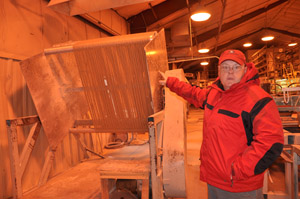Calendar Icon
May 20, 2011
Person Bust Icon
By Carole Wilbeck | Engineering
![]() RSS
Submit a Story
RSS
Submit a Story

Completing a senior project for Nebraska Engineering’s MECH 447 class is a great feeling for many students. For Cassie Teeter, Mike Lucis and Tom Frederick, the feeling was even better: knowing their project is being put into production, adding jobs to the Nebraska economy.
Working with Professor Bill Dick, their team found a real-world opportunity with Hughes Bros. of Seward: designing a mechanism to bend wet composite material into a zig-zag piece of rebar. Hughes Bros., with 300 employees, manufactures items for power line transmission and other structures. The company, founded in 1921, aims to expand its products with NU-Tie: a strong-yet-light wall reinforcement component developed by Maher Tadros, a professor with UNL Civil Engineering.
Mechanical Engineering students Teeter, Lucis and Frederick presented their design in December 2010 for an automated machine to reform composite rebar. The audience included Matt Stryson, P.E., Hughes Bros. Plant Engineer and a Nebraska Engineering alumnus, who says the company will implement the operation in 2011.
The team’s design includes a conveyor type of system with a chain assembly with motors, insulated gearboxes and tensioners to make the NU-Tie’s characteristic zig-zag shape and move the material through a 350-degree oven (9’6” wide x 8’0” long x 10’6” high with a 10” x 70” opening) for 90 seconds of curing. This machine will automate a manual process currently performed outside the USA and, as a result, will bring those jobs home to Seward, said Dick, whose industry connections enhance opportunities in the senior project course.
Teeter (now Mott, following her recent marriage), Lucis and Frederick addressed safety features for the apparatus and projected its addition would generate two jobs with salaries estimated at $40,000 per year. The proposal’s total for purchased and manufactured parts was $94,412 but first-year earnings were outlined at $150,000 per year.
Mott said she enjoyed the project and “learned a lot about how to move through a project and hit the deadlines”; she also realized “how fluid projects in the working world need to be.”
Frederick said he appreciated building on his prior design experiences, working in Professor Shane Farritor’s mechatronics lab on-campus.
The team agreed it was good career preparation to go through “all the steps of a real project, including design reviews, weekly meetings with our supervisor, a final presentation, and a final proposal,” Mott said, with leadership and delegation skills applied along the way.
Lucis praised Hughes Bros. for supporting the project and the team’s ideas, and partnering in areas where the students were still learning. He added: “They really made sure that not only was this project a success, but that we learned the skills we would need to make our future projects successful.”
“It is amazing to know that something we have done in school is really going to be put to use and help Hughes Brothers to gain a lot of extra business, as well as create jobs for Seward,” said Mott, who described the experience as “invaluable for my future work in mechanical engineering, to have been part of a project that has such a great impact.”
For a list of other recent Nebraska Engineering senior projects, view the 2011 E-Week Guide.
Submit a Story